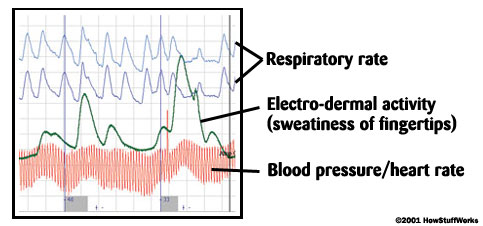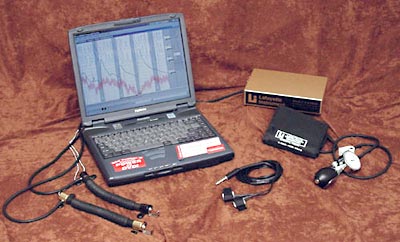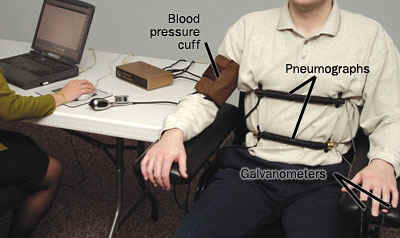|
|
|
How does a lie detector (polygraph)
work? |
by Kevin
Bonsor
|
| You hear about lie
detectors all the time in police investigations, and
sometimes a person applying for a job will have to undergo a
polygraph test (for example, certain government jobs with the
FBI or CIA require polygraph tests). The goal of a lie
detector is to see if the person is telling the truth or lying
when answering certain questions.
When a person takes a polygraph test, four to six
sensors are attached to the person. A polygraph is a
machine in which the multiple ("poly") signals from the
sensors are recorded on a single strip of moving paper
("graph"). The sensors usually record:
- The person's breathing rate
- The person's pulse
- The person's blood pressure
- The person's perspiration
Sometimes a
polygraph will also record things like arm and leg movement.
When the polygraph test starts, the questioner asks three
or four simple questions to establish the norms for the
person's signals. Then the real questions being tested by the
polygraph are asked. Throughout questioning, all of the
person's signals are recorded on the moving paper.
Both during and after the test, a polygraph examiner can
look at the graphs and can see whether the vital signs changed
significantly on any of the questions. In general, a
significant change (such as a faster heart
rate, higher blood
pressure, increased perspiration)
indicates that the person is lying.
When a well-trained examiner uses a polygraph, he or she
can detect lying with high accuracy. However, because the
examiner's interpretation is subjective and because different
people react differently to lying, a polygraph test is not
perfect and can be fooled.
|
| For
more than 15 years, Robert Hanssen led a double life.
In one life he was a 25-year veteran with the Federal Bureau of Investigation
(FBI) who had access to some of the nation's most-classified
information. In his other life, he allegedly was spying for
the Russian government. Hanssen's deception was finally
discovered, and in February 2001 he was arrested and later
pled guilty to 15 espionage-related charges. Spies are
probably the world's best liars, because they have to be, but
most of us practice deception on some level in our daily
lives, even if it's just telling a friend that his horrible
haircut "doesn't look that bad."

Photo courtesy Lafayette
Instrument
An analog
polygraph instrument
Most analog polygraphs are being
replaced by digital devices.
|
People tell lies and deceive others for many reasons. Most
often, lying is a defense mechanism used to avoid trouble with
the law, bosses or authority figures. Sometimes, you can tell
when someone's lying, but other times it may not be so easy.
Polygraphs, commonly called "lie detectors," are
instruments that monitor a person's physiological reactions.
These instruments do not, as their nickname suggests, detect
lies. They can only detect whether deceptive behavior is being
displayed.
Do you think you can fool a polygraph machine and examiner?
In this article, you'll learn how these instruments monitor
your vital signs, how a polygraph exam works and about the
legalities of polygraph testing.
|
Man vs. Machine
A polygraph instrument is
basically a combination of medical devices that are used to
monitor changes occurring in the body. As a person is
questioned about a certain event or incident, the examiner
looks to see how the person's heart
rate, blood
pressure, respiratory
rate and electro-dermal
activity (sweatiness, in this case of the fingers) change
in comparison to normal levels. Fluctuations may indicate that
person is being deceptive, but exam results are open to
interpretation by the examiner.

Source: Lafayette Instrument
Physiological responses recorded by a
polygraph
|
Polygraph exams are most often associated with criminal
investigations, but there are other instances in which they
are used. You may one day be subject to a polygraph exam
before being hired for a job: Many government entities, and
some private-sector employers, will require or ask you to
undergo a polygraph exam prior to employment.
Polygraph examinations are designed to look for significant
involuntary responses going on in a person's body when that
person is subjected to stress, such as the stress associated
with deception. The exams are not able to specifically detect
if a person is lying, according to polygrapher Dr. Bob
Lee, former executive director of operations at Axciton
Systems, a manufacturer of polygraph instruments. But
there are certain physiological responses that most of us
undergo when attempting to deceive another person. By asking
questions about a particular issue under investigation and
examining a subject's physiological reactions to those
questions, a polygraph examiner can determine if deceptive
behavior is being demonstrated.

Photo courtesy Lafayette
Instrument
Today, most
polygraph exams are administered with digital equipment
like
this.
|
The polygraph instrument has undergone a dramatic change in
the last decade. For many years, polygraphs were those
instruments that you see in the movies with little needles
scribbling lines on a single strip of scrolling paper. These
are called analog polygraphs. Today, most polygraph
tests are administered with digital equipment. The scrolling
paper has been replaced with sophisticated algorithms and computer
monitors.

Photo courtesy Lafayette
Instrument
Parts of a
polygraph that monitor physiological responses
|
When you sit down in the chair for a polygraph exam,
several tubes and wires are connected to your body in specific
locations to monitor your physiological activities. Deceptive
behavior is supposed to trigger certain physiological changes
that can be detected by a polygraph and a trained examiner,
who is sometimes called a forensic psychophysiologist
(FP). This examiner is looking for the amount of fluctuation
in certain physiological activities. Here's a list of
physiological activities that are monitored by the polygraph
and how they are monitored:
- Respiratory rate - Two pneumographs,
rubber tubes filled with air, are placed around the test
subject's chest and abdomen. When the chest or abdominal muscles
expand, the air inside the tubes is displaced. In an analog
polygraph, the displaced air acts on a bellows, an
accordion-like device that contracts when the tubes expand.
This bellows is attached to a mechanical arm, which is
connected to an ink-filled pen that makes marks on the
scrolling paper when the subject takes a breath. A digital
polygraph also uses the pneumographs, but employs
transducers to convert the energy of the displaced
air into electronic signals.
- Blood pressure/heart rate - A blood-pressure
cuff is placed around the subject's upper arm. Tubing runs
from the cuff to the polygraph. As blood pumps through the
arm it makes sound; the changes in pressure caused by the
sound displace the air in the tubes, which are connected to
a bellows, which moves the pen. Again, in digital
polygraphs, these signals are converted into electrical
signals by transducers.
- Galvanic skin resistance (GSR) - This is also
called electro-dermal activity, and is basically a
measure of the sweat
on your fingertips. The finger tips are one of the most
porous areas on the body and so are a good place to look for
sweat. The idea is that we sweat more when we are placed
under stress. Fingerplates, called galvanometers, are
attached to two of the subject's fingers. These plates
measure the skin's ability to conduct electricity. When the
skin is hydrated (as with sweat), it conducts electricity
much more easily than when it is dry.
Some polygraphs also record arm and leg movements. As the
examiner asks questions, signals from the sensors connected to
your body are recorded on a single strip of moving paper. You
will learn more about the examiner and the test itself later.
|
|
To Polygraph page 2
| | |

